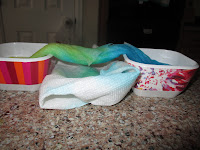Materials Needed for Basic Robots:
Hot glue gun & glue sticks
Wooden squares and rectangles
Paint & brushes
Spray primer
Materials Needed for Embellishments:
Magnets
Googly eyes
Glue dots & E600 glue
Stickers
Beading wire & basic tools
Small beads
I bought a small bag of wooden shapes at the craft store. After sorting them into piles of large and small squares and rectangles (which is fun to have your kids help with as it promotes early math skills), I used a hot glue gun to attach a large square (head) to a large rectangle (body), then used small rectangles for legs and arms. If you wanted shorter arms or legs the small squares would work equally well. I haven't used my hot glue gun in a while, and the glue got a little messy! If I were to do it again, I would stop after gluing on the appendages and wipe off the excess glue on the front of the robot before it hardens.
After the robots were glued together I put them in box and spray painted them with primer on both front and back. After the primer dried I used four metallic paint colors to make the robots look shiny; one coat on back and two on front gave them a nice finish.
The fun part was making embellishments for the robots! I used medium googly eyes attached with glue dots for the robots eyes. I found that the larger the googly eyes, the cuter the robot! The metallic round stickers that I used were perfect for layering, and gave the robots the look of having some kind of front panel without a lot of detailed marker use. The antenna for each robot was made with wire and small beads. I used my basic beading tools to snip the wire at my desired length (either double- or single-antenna). The double-antennae are one longer piece of wire with beads at each end, which is then glued to the robot in the middle of the wire. The single-antenna are one piece of wire with a bead at one end and glued to the robot at the other end. My grasping tool was essential in holding the wire as I twisted it around the bead to make it tight; I have carpal tunnel and arthritis in my hands, so detailed fine motor work can be a challenge for me.
 After making enough antenna, I flipped all of the robots over and glued the antennae to the back of the head. I placed a small strip of paper over the glue to help hold the antennae in place while the glue dried. I also used my E600 glue to attach circle magnets to the back of each robot. I like E600 glue because it is strong enough to support magnets and will come off of hands fairly easily.
After making enough antenna, I flipped all of the robots over and glued the antennae to the back of the head. I placed a small strip of paper over the glue to help hold the antennae in place while the glue dried. I also used my E600 glue to attach circle magnets to the back of each robot. I like E600 glue because it is strong enough to support magnets and will come off of hands fairly easily. Each of my robots is about 4 inches tall. Although they aren't as 'polished' as ones that you might be able to purchase (if this is something you could find easily?) I like these cute little robots. They were fun to make and should make the birthday boy and his friends happy! You could extend this idea by using markers to create more elaborate panels, make different facial features, or have kids decorate their own robot. It is amazing what you can create with basic shapes and a little bit of imagination!










